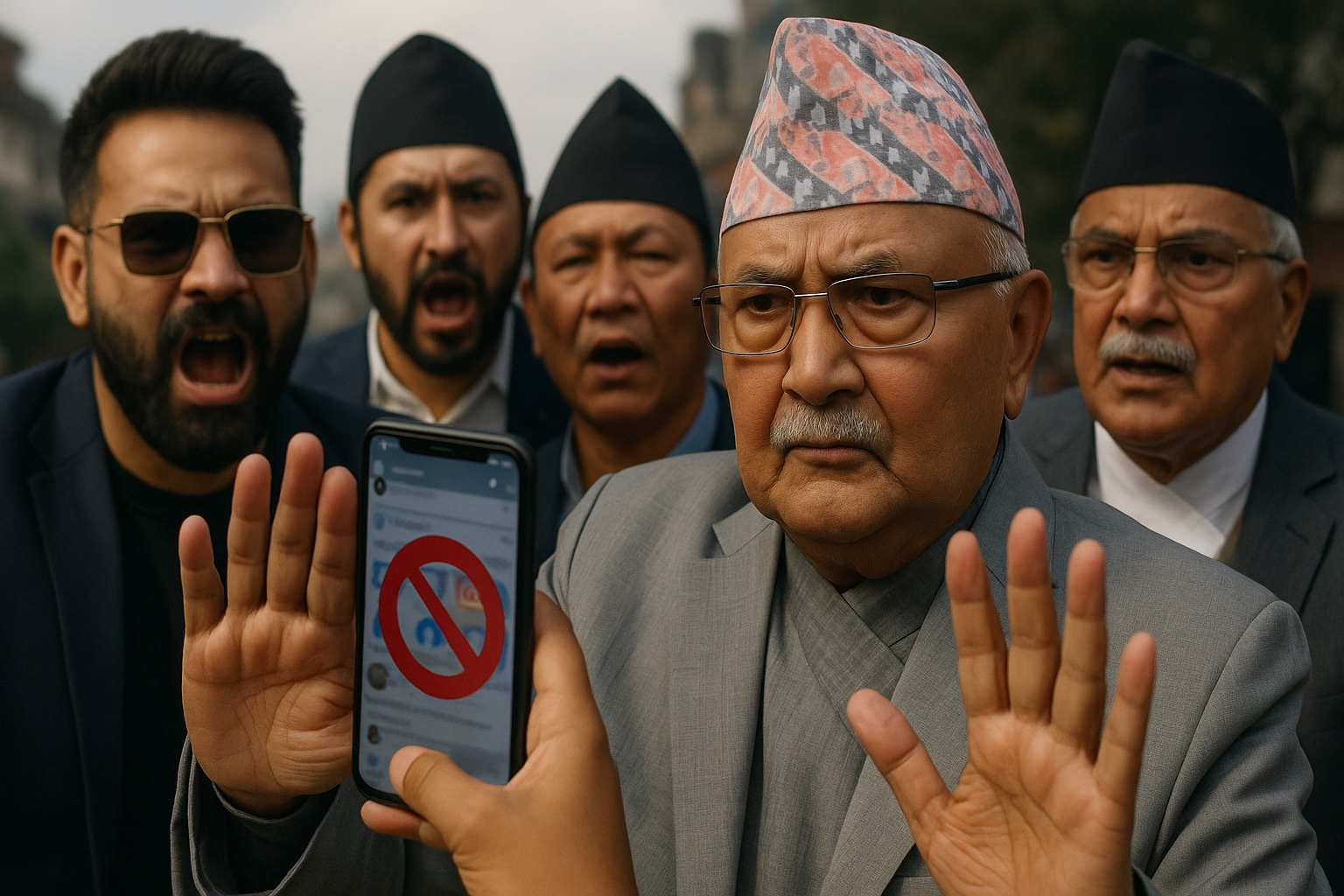Crisis in 26 Letters: The A–Z Truth Behind Nepal’s Digital Gag Order

Nepal has been thrust into a storm of political and social debate following Prime Minister K.P. Sharma Oli’s decision to impose a sweeping ban on major social media platforms, including Facebook, YouTube, and TikTok. The government justified the move on technical grounds, citing the platforms’ failure to formally register in Nepal and referencing a Supreme Court order on digital regulation. Officials also argued the ban was necessary to curb rising cybercrime and online abuse.
Yet critics insist the real motive runs far deeper. They see the ban as an attempt to silence growing dissent against the Oli administration. Within hours of the announcement, prominent political figures openly defied the decision. Kathmandu Mayor Balen Shah mocked the ban on Facebook itself, former Prime Minister Pushpa Kamal Dahal “Prachanda” denounced it as unconstitutional and undemocratic, Dharan Mayor Harka Sampang ridiculed it by posting updates almost every hour, and Rabi Lamichhane’s Rastriya Swatantra Party used social media to mobilize its supporters.
The backlash has fueled what intelligence agencies now call a rising “digital threat” to the government, as opposition leaders increasingly turn to online platforms as their main battleground. Analysts warn that the ban has backfired, amplifying criticism rather than silencing it, while disrupting communication for millions of Nepalis — especially migrant workers and their families who rely on social media to stay connected.
This clash between Oli’s administration and a digitally empowered opposition is now being framed as more than a regulatory dispute. It has become a struggle over freedom of expression, democratic accountability, and the future of Nepal’s digital rights. The A–Z dossier maps out every dimension of this controversy — from political motives and social impacts to legal ambiguities and international concerns — revealing how a policy meant to assert control has instead ignited one of Nepal’s fiercest debates in the digital age.
A–Z Report: Social Media Ban in Nepal?
A – Announcement
The Oli government announced a nationwide ban on major social media platforms (Facebook, YouTube, TikTok, etc.), citing registration issues and a Supreme Court interpretation.
B – Balen Shah
Kathmandu’s outspoken mayor immediately defied the ban by posting on Facebook, mocking the decision and calling it a move to silence voices.
C – Constitutional Concerns
Former PM Prachanda branded the ban unconstitutional, undemocratic, and a violation of freedom of expression guaranteed by Nepal’s constitution.
D – Digital Threat
Intelligence agencies now warn Oli faces his greatest “digital threat” from within — Balen, Prachanda, Harka Sampang, and Rabi Lamichhane, all using social media to challenge the government.
E – Economic Impact
The ban disrupts communication between millions of Nepali migrant workers abroad and their families, potentially impacting remittances and digital commerce.
F – Freedom of Expression
Civil society groups say this is the harshest crackdown on free speech in Nepal’s democratic history.
G – Government’s Justification
Officials argue the platforms are unregistered and increasingly linked to crimes, online fraud, and cyberbullying.
H – Harka Sampang
Dharan’s mayor openly mocked the ban by posting hourly on Facebook, turning it into a symbolic protest.
I – International Reaction
Global observers fear Nepal is sliding toward digital authoritarianism, comparing it with restrictions in authoritarian states.
J – Judiciary
The government cited a Supreme Court ruling on regulating unregistered digital platforms, but critics say the decision was misinterpreted.
K – K.P. Sharma Oli
The Prime Minister is accused of using the ban as a tool to silence dissent, not to control crime.
L – Law Enforcement
Nepal Police struggle with impartial investigations; critics argue better policing, not bans, are needed.
M – Migrant Workers
The ban has made daily communication harder for families of Nepalis abroad, sparking anger.
N – Net Neutrality
Even before the ban, Nepal Telecom had been criticized for violating net neutrality by selling Facebook/YouTube-specific data packs.
O – Opposition Leaders
Beyond Prachanda, Balen, Harka, and Rabi, other opposition groups see this as a chance to rally public anger against the government.
P – Political Motive
Analysts argue the ban’s true motive is to control rising online criticism, not crime or regulation.
Q – Question of Enforcement
Despite the ban, top leaders are still using the platforms. Citizens question: If leaders can, why can’t ordinary people?
R – Rabi Lamichhane
His supporters launched online campaigns defying the ban, fueling the sense of a digital revolt.
S – Security Agencies
The National Intelligence Department frames the online defiance as a “cyber army” threat. Critics call it exaggeration.
T – Technical Issues
The platforms remain unregistered, but experts argue the government should enforce regulation, not shut them down.
U – Unrest
Digital frustration is rising — with citizens angry over lost connectivity, digital economy disruptions, and censorship.
V – Voices of Protest
Protests are not just on the streets but also online, showing the ban’s impracticality.
W – Weak Institutions
Nepal’s policing, regulatory, and legal institutions are weak — leading to “ban first, fix later” policies.
X – Xenophobia & Influence
Critics say Chinese influence and authoritarian-style policies may be shaping Oli’s digital governance approach.
Y – Youth Anger
Nepal’s young population, heavily reliant on social media, feels betrayed and silenced.
Z – Zero-Sum Game
In the end, the ban appears to be a zero-sum game: it fails to stop crime, undermines democracy, fuels online resistance, and leaves Oli politically weaker.
Facebook Social Media



![From Kathmandu to the World: How Excel Students Are Winning Big [Admission Open]](https://www.nepalaaja.com/img/70194/medium/excel-college-info-eng-nep-2342.jpg)
